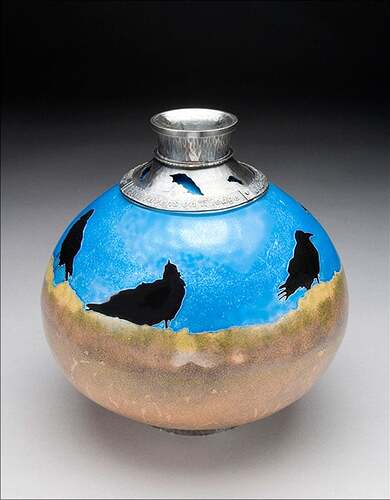Materials: copper, enamel, silver
Dimensions: 8 x 7 x 7 inches
Copper vessel spun in two parts and soldered together. Enameled using cloisonne and sifting techniques. Top is constructed of silver.
Photo credit: Rafael Molina
Harlan W Butt
Harlan W. Butt, Metalsmith
Denton, Texas. USA
The earth, its plants and animals, inspire me to create. The making of art is more than a record of these things, it is part of the activity of discovering connections. The patterns in my cloisonné represent nature’s repetition in structure and surface. Words are the human marks we make to signify meaning.
The contemporary dialogue focusing on the environment and the global impact of human habitation on its health and diversity involves serious debate on issues concerning conservation versus preservation of wilderness, capitalism as a sustainable system of economics on a planet of limited natural resources, anthropocentrism, as opposed to biocentrism, as a world view and accusations of environmentalism as a new form of Western imperialism. Nature is no longer as simple as appreciating the beauty of a flower. And yet beauty exists and its power and frailty reminds us to enjoy each moment and not take for granted our own tiny place in the universe.
These containers and vessels definitely hold their place in the world of stunning art objects as well as in the world of metalsmithing.
Since the dawn of time humans have created containers to hold things that were important to them, from large vessels to hold food and harvests to intimate containers for small precious things. They might hold memories, ashes, medicine, beverage, fruit or food - but all spring from the imagination and skill of the maker. Some have specific religious functions, some are meant for everyday use. When one thinks of a vessel or container the inclination is to think of something with solid walls - yet many of these works involve the exploration of positive and negative space, and the use of negative space to help create the illusion of the wall of the vessel.
As the world’s largest jewelry related internet site, Ganoksin strives to develop exhibitions showcasing work from around the world. This exhibition was open to all metalsmiths, professional and amateur, advanced and beginner. Participants are from The Netherlands, the USA, Canada, Australia, Costa Rica, the United Kingdom, Israel, Hong Kong, Colombia, Romania, Italy, Ireland, Japan, Malaysia and Denmark. While most of the pieces are by an individual metalsmith, some are collaborations, one of three artists spanning 50 years.
In total 319 artists contributed 729 show pieces for the permanent online exhibition.
Objects in the exhibition include boxes, lockets, urns, ash containers, bowls, wine cups, reliquaries, match holders, vases, teapots, pitchers, sugar bowls, baskets, nests, pillboxes, clutches and a range of sculptural forms. A variety of techniques are showcased covering a wide range of metalsmithing techniques. Materials used include everything from gold and silver to less expensive metals. Ornamentation includes the addition of enamel, chasing and repousse’, gemstones and found objects.
The exhibition was curated by Beth Wicker, President of the North Carolina Society of Goldsmiths in the United States, and Adjunct Instructor at Northeastern Technical College in South Carolina. Director of the exhibition is Hanuman Aspler, founder of The Ganoksin Project, the world’s largest internet jewelry site.
